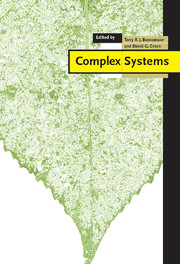Book contents
- Frontmatter
- Contents
- 1 Introduction
- 2 Self-organisation in complex systems
- 3 Network evolution and the emergence of structure
- 4 Artificial life: growing complex systems
- 5 Deterministic and random fractals
- 6 Non-linear dynamics
- 7 Non-linear control systems
- 8 Parallel computers and complex systems
- 9 Are ecosystems complex systems?
- 10 Complexity and neural networks
- Index
4 - Artificial life: growing complex systems
Published online by Cambridge University Press: 04 August 2010
- Frontmatter
- Contents
- 1 Introduction
- 2 Self-organisation in complex systems
- 3 Network evolution and the emergence of structure
- 4 Artificial life: growing complex systems
- 5 Deterministic and random fractals
- 6 Non-linear dynamics
- 7 Non-linear control systems
- 8 Parallel computers and complex systems
- 9 Are ecosystems complex systems?
- 10 Complexity and neural networks
- Index
Summary
Introduction
The possibility of constructing systems so complex and functional that they might be considered alive is now upon us. We are all witnesses of the explosive growth in technology, but are there limits to the complexity of the systems we can construct? Technology operates within the constraints of nature. Yet under the same constraints biological evolution constructed living systems, the source of much admiration and wonder. For many years to come natural living systems with all their complexity and relative perfection will be the model for the construction of artefacts.
At one level living systems can be seen as arrangements of interacting atoms. However a knowledge of quantum electrodynamics does not help us to understand the behaviour of bacteria nor the replication of cells, even though it is clear that there is no magic force behind life. Living systems show organisation of their component parts at each hierarchical level. At the level of biochemistry living systems are organised macromolecules. The tissue of higher organisms consists of organised cells. Our knowledge of atoms, macromolecules, cells, tissues, organs, individual living systems and upwards in the hierarchy of living systems indicates that what we can only vaguely define and call ‘life’ is always characterised by the arrangement of parts.
If a caveman were able to see a skyscraper how would he describe it? Maybe he would see similarities to a cave (Lem, 1977). The scientist studying the elegant compositions of living systems often compares them with machines (Monod, 1972) for want of a better analogy.
- Type
- Chapter
- Information
- Complex Systems , pp. 91 - 126Publisher: Cambridge University PressPrint publication year: 2000
- 6
- Cited by



